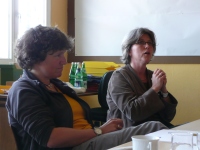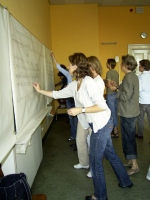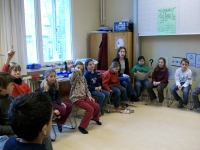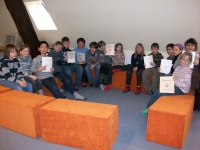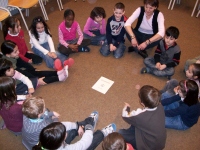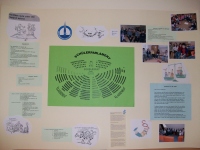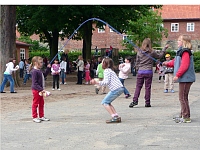
Results of the First Work Phase
On the 26th of February 2010, Hildegard Kurt and Barbara Geck, School Director, presented the results of the “Warmth Sculpture Workshop Heiligengeist School”.
Barbara Geck: "Heiligengeist School’s catchment area is characterised by a broad spectrum of social, cultural and intellectual differences. Our task is to create a common learning culture for all these different children.
At the same time we were confronted with dealing with the education policy backlog of the last thirty years. However intensively we tried, we were limited in the realisation of our concepts due to a lack of resources. Despite working to the point of exhaustion every day, there seem to be no measurable results. This has a considerable impact on job satisfaction.
How refreshing the work in the Warmth Sculpture Workshop then was. We experienced another quality of time; pausing and looking beyond our own noses. We were able to perceive what we had already achieved over the last years and how far we had already come. The feedback that the two artists gave us about our work meant a special appreciation for us. Coming from outside they perceived things as precious which we took for granted, or no longer even noticed.
During these weekends we worked intensively for two whole days. In spite of this on Monday morning we started the new week mentally restored, looking forward to working with the children. All workshop participants experienced this energy and are full of motivation and enthusiasm.
We are trying to carry the appreciation which we experienced in the workshops further into our teaching – for instance by being in our classrooms ten minutes earlier every morning.
Thanks to the three workshops we were able to find new structures which place the protagonists, our children, back into the centre.”
KEY RESULTS OF THE WARMTH SCULPTURE WORKSHOP
The calm opening phase before class begins
The children enter the building at 7.50am. Classes begin at 8am. During this 10 minute gap conflicts sometimes arise which hinder class work. In order to counteract this, all form teachers are now in their classrooms from 7.50am. They welcome the children and have a sympathetic ear for them.
Although this means longer working hours, it is a real benefit – for the children and the teachers.
From tight timing to a breathing rhythm
Much of the restlessness, stress and aggression that can exist in a school stems from the 45 minute periods. It means permanent change of teachers and squeezes learning into a tight scheme, breaking it blindly and mechanically. The Heiligengeist School has transformed this stiff structure into a quieter, breathing rhythm:
I. The form teacher blocks at the beginning of the day
Differently to before, now both the first and second teaching hours are in the hands of the form teacher. This, together with the calm opening phase, creates space and time for daily rituals and offers stability to the children.
II. Classes in specific subjects in 90-minute blocks
Teaching hours 3-4 and 5-6 will also consist largely of 90-minute blocks. The teachers will no longer need to change class after 45 minutes, which caused restlessness and stress.
Furthermore the timetable will now be designed so that teachers who teach life skills as well as English, for example, can work together with the children for four teaching hours - and can, for example, teach the children about a healthy breakfast followed by a practical session which lasts more than two hours. English can be caught up on during the next lesson.
A teacher: “We experience that the children immerse themselves completely differently in the class work. The so-called ‘flow’ occurs. They lose track of time. They learn to involve themselves with subjects more intensely whereas before they had experienced that after 45 minutes everything was over – it was similar to a remote control: switching channels again and again”.
III. The school bell rings less
Where a calm, flowing rhythm is intended, the ring of the school bell causes a disturbance. Therefore the bell rings now only rings four times a day: at 7.50am - the beginning of the school day, at the end of the two long breaks and at 1.20pm - the end of the school day.
The Class Council and the Pupils’ Council
It became clear in the Warmth Sculpture Workshop how in school the needs of the children and adults are often similar. For instance the need for a quiet environment that offers space for deeper, open learning processes.
Another such need is the longing for a real community. The children too want to be appreciated in class and in the school. They want to have a say, participate and contribute.
Therefore there is now a Class Council and a Pupils’ Council at the Heiligengeist School.
The Class Council takes place in every class once a week. It helps to clear up conflicts; to develop self-appreciation; to build better relationships; to learn to accept other points of view; to develop values and to experience how helpful and precious dialogue is for communities and groups.
The Pupils' Council
The class speakers write the issues dealt with in the Class Council into the “golden book” which they carry to the Pupils’ Council. The current issue there is the chronic conflict about soccer in the yard. Who can play, where, when with whom? The Pupils’ Council is trying to find their own solutions for this.
From the beginning both the Class Council and the Pupils’ Council have been very popular with the children. They are interested and committed. In the council meetings there are no discipline problems. They carry their “golden book” conscientiously and use it. It is as if they had waited for the opportunity to have more exchange with each other and to contribute to the school being a nice, pleasant place.
Towards a Pupils’ Parliament
In a next step the school intends to add a Pupils’ Parliament to the Pupils’ Council: a forum where all pupils experience themselves as part of the school community, where transparency is created and conflicts can be addressed and solved together – in short, where democracy is learned by practicing it.
Improved atmospheres in the classrooms
After the third workshop several teachers surveyed their respective classrooms together with artist George Steinmann and colleagues. The point of interest was: How do others feel in my classroom? How can I improve the atmosphere with simple means? How does the room express my appreciation of the children and our joint working process?
Since then, there has been quite a lot of clearing out, tidying up, redesigning, cleaning and painting.
More support from the parents
In reading groups, with computer courses on Saturdays for children or by cleaning the windows, which have been dirty for many, many years. Since the Warmth Sculpture Workshop some parents are offering more of their support.
Perspectives
Barbara Geck, Director: “The changes first need to become really consolidated and established. My dearest wish then is that we can further unfold our sense of real community within the school. That means: more commitment to agreements and even more reliability. It might seem that this might not have a very big effect, but that’s wrong.”
Tanja Staats, Assistant Director: “How can the pedagogical value of all these structural changes fully unfold? How does it really change our teaching? Where should we maybe consider co-operations between classes? What counts now is to make full use of the new possibilities to refine and deepen the school’s culture.”
This again is a process that needs calm, space, time and support.
"Through the Warmth Sculpture Workshop we have more self-confidence as a school. We see: we are doing lot. And we want to concentrate on what we do, do it better, more precisely, more calmly. Actually this is inner growing. Not more, but simply more quality." Teacher
"In schools both children and adults are confronted with aims and objectives that have to be fulfilled. In the Warmth Sculpture Workshop we worked the other way round.
At the beginning of our workshop process no prescribed aims were set. Instead we started with questions like: What are the real needs of the children and ourselves as teachers? What exactly are our strengths? What hinders us from unfolding these strengths in the school? The results of our work grew out of the process, out of what we ourselves had identified as important.
Was it this authentic working from inside out that led us to such concrete results? That then were and are so quickly put into practice?" Hildegard Kurt
The newly created Class Council in a meeting.
The delegates of the Class Council meet in the Pupils' Council. They are holding their Golden Books.
Another Class Council meeting.
The green poster in the middle of the wall shows the structure of the future Pupils' Parliament.
"I intend to introduce something new to my class. When the next school year begins I will greet the new children every morning with a handshake so that every child feels welcome. It's a kind of appreciation: I see you, you are here." Teacher
"We consider ourselves a school wich creates a consciousness for existing strengths - in our children, in ourselves and in our school life." Teacher
